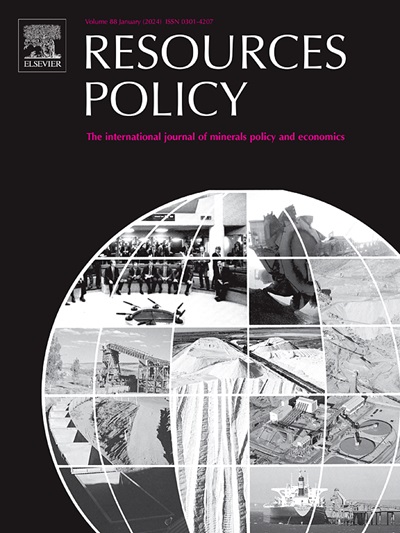巴西煤炭循环的概述:一种基于采样方法,表征和废物价值的新的可持续方法
IF 10.2
2区 经济学
0 ENVIRONMENTAL STUDIES
引用次数: 0
摘要
煤炭是全球重要的能源来源,巴西拥有大量储量。然而,在巴西,大约50%的煤炭被作为废物丢弃,通常混合成单一材料而没有选择性表征。本研究旨在建立一个框架,以帮助矿业公司在研究区域确定和实施可持续煤炭开采实践战略。收集残余馏分样品并对其特征和潜在应用进行分析。结果表明,废土中粘土含量受煤层年龄和深度的影响,而黄铁矿含量则由选矿工艺决定。基于这些发现,四组残余馏分被确定为特定的应用。第1组含碳量较高,适合加工和碳浓度。第2组,其特点是黄铁矿含量低,粒度粗,pH值中性,可用于陶瓷和砂浆粘土矿物的浓缩。第3组,富含粘土矿物,适用于肥料、技术土、火山灰和地聚合物。第4组包括具有黄铁矿浓度潜力的样品。本研究强调了系统的废物抽样和评估的价值,为促进循环经济提供了有效的策略。这种方法通过释放煤炭开采废物的潜力,支持研究区域及其他地区的可持续发展。本文章由计算机程序翻译,如有差异,请以英文原文为准。

An overview of the coal circularity in Brazil: A new sustainable approach based on sampling method, characterization, and waste valorization
Coal is a key energy source globally, and Brazil holds substantial reserves. However, approximately 50% of the coal extracted in Brazil is discarded as waste, often mixed into a single material without selective characterization. This study aims to establish a framework to help mining companies identify and implement strategies for sustainable coal mining practices in the study region. Residual fraction samples were collected and analyzed for their characteristics and potential applications. The results showed that the clay content in the waste is influenced by the age and depth of the coal deposits, while the beneficiation process determines the pyritic content. Based on these findings, four groups of residual fractions were identified for specific applications. Group 1, with higher carbon content, is suitable for processing and carbon concentration. Group 2, characterized by low pyrite content, coarse granulometry, and neutral pH, may be used to concentrate clay minerals for ceramics and mortars. Group 3, rich in clay minerals, is suitable for fertilizers, techno-soils, pozzolans, and geopolymers. Group 4 includes samples with potential for pyrite concentration. This study highlights the value of systematic waste sampling and evaluation, providing an effective strategy to promote the circular economy. This approach supports sustainable development in the research region and beyond by unlocking the potential of coal mining waste.
求助全文
通过发布文献求助,成功后即可免费获取论文全文。
去求助
来源期刊

Resources Policy
ENVIRONMENTAL STUDIES-
CiteScore
13.40
自引率
23.50%
发文量
602
审稿时长
69 days
期刊介绍:
Resources Policy is an international journal focused on the economics and policy aspects of mineral and fossil fuel extraction, production, and utilization. It targets individuals in academia, government, and industry. The journal seeks original research submissions analyzing public policy, economics, social science, geography, and finance in the fields of mining, non-fuel minerals, energy minerals, fossil fuels, and metals. Mineral economics topics covered include mineral market analysis, price analysis, project evaluation, mining and sustainable development, mineral resource rents, resource curse, mineral wealth and corruption, mineral taxation and regulation, strategic minerals and their supply, and the impact of mineral development on local communities and indigenous populations. The journal specifically excludes papers with agriculture, forestry, or fisheries as their primary focus.
 求助内容:
求助内容: 应助结果提醒方式:
应助结果提醒方式:


